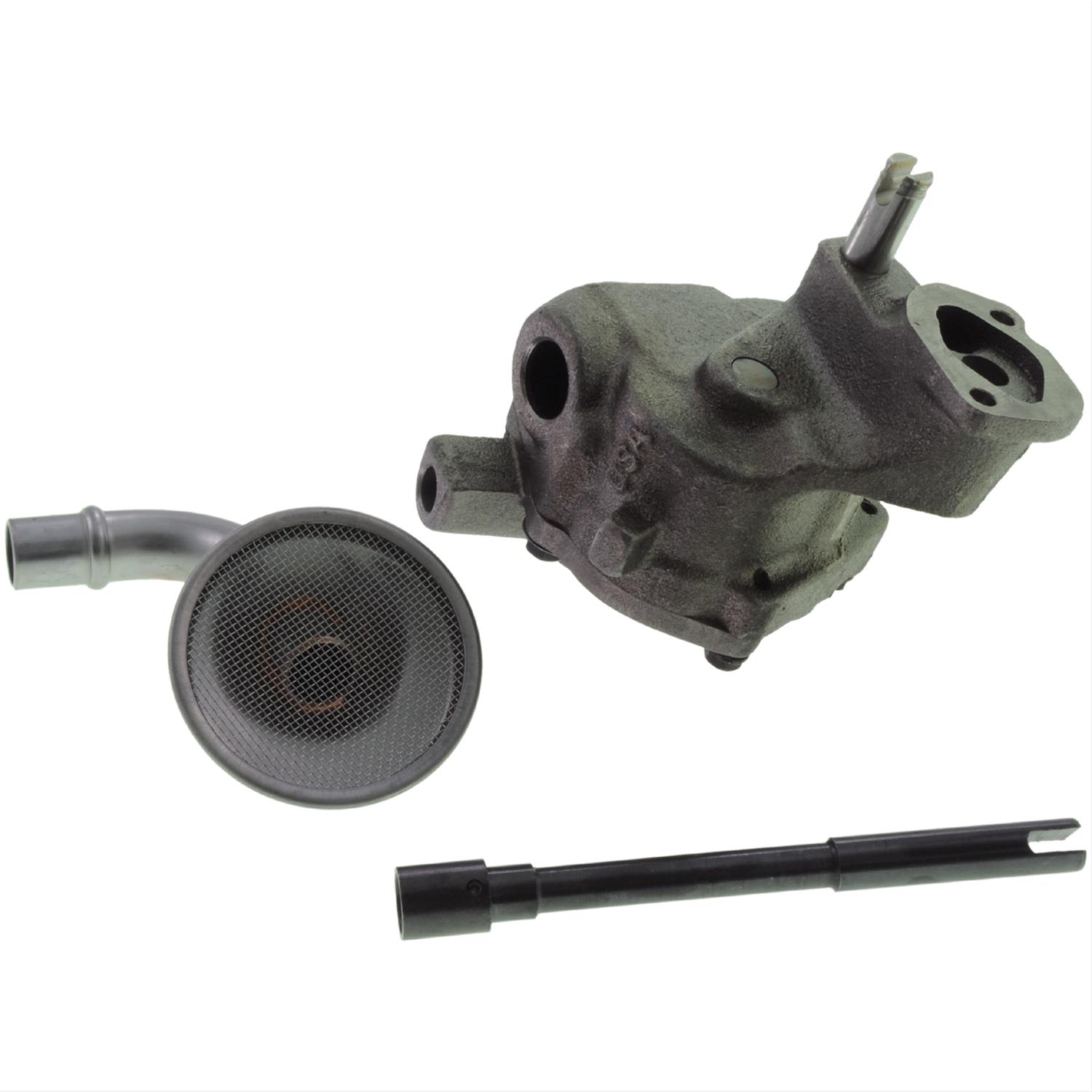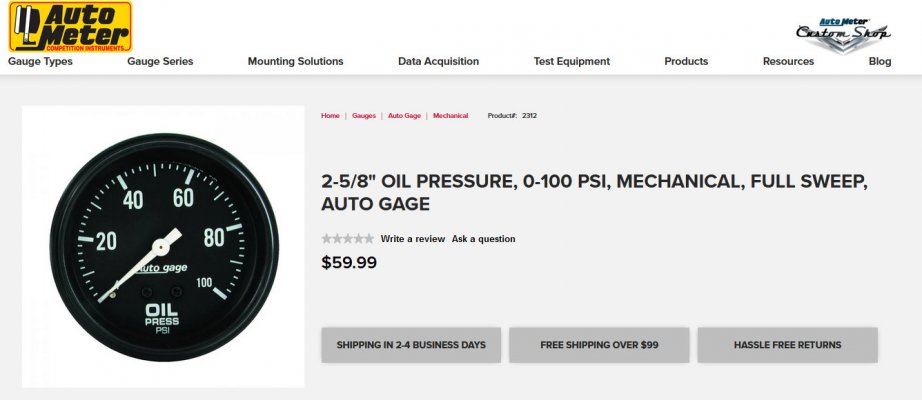My 98 K1500’s “Check Gages” light illuminates when the engine is warm.
I understand that this is not uncommon.
I have confirmed recently that the pressure is indeed low, but not exactly how low it gets. I think I saw 12 psi, but hadn’t driven it too hard that time.
I’m thinking about installing the M99HVS to keep the volume/pressure up to hopefully prolong the life of my engine.
I have the 5.7 all stock. Has anyone else done this?
Will that pickup work with my original pan?
Is this even a good idea?
Greetings George,
Over the years either my friends or I would find ourselves in a similar situation,
where the oil pressure was low at a hot idle, but otherwise the engine was still running
alright. (And usually we needed to keep the engine running as long as possible
in order to keep driving to work while finding/building up another engine to replace
the tired one.)
As mentioned in previous posts, the short (& most correct) answer is that a high volume
pump and/or changing the oil viscosity is a short term fix at best. And I'm
not going to argue the point. On the other hand, instead of just letting the
engine wear/fail near-term from too-low oil pressure at a hot idle, if I can make a
simple change & monitor the engine oil pressure carefully, and nurse the engine
down the road for another 6-12 months, then that's a win in my book & I'm willing
to make the extra effort.
NOTE: The following is based on firsthand experience that I wouldn't hesitate to
tell my daughters to do.
****
OK, then. What I would suggest is that if you haven't already done so, let's
change the viscosity of the oil that you are putting into this engine and then
see if this makes a noticeable change to your hot engine oil pressure.
Now this used to be a widely accepted practice, but thanks (primarily) to increasingly tight
CAFE standards and (secondarily) to tighter tolerances, recommending anything other than
a 5W-20 or 5W-30 oil today causes great consternation. As this trend continues, 0W-16 (Honda)
& 0W-40 (European) oils are now becoming the norm for the latest engines.
(Disclaimer: And of course, if anyone reading this is driving an engine still under
warranty, then of
course whatever you are instructed to run in order to keep the warranty valid is the only thing to use.)
Before we start talking about specific recommendations, here is the warranty guidance from
the '99 C/K Service Manual having to do with engine oil viscosity vs ambient temperatures.
(This is the same as what you would find in the '98 manual for your vehicle.)
GM '99 C/K Service Manual, Vol. 1, "Maintenance & Lubrication", p. 0-69
You must be registered for see images attach
You didn't mention what weight oil you are currently running, and I don't know if you are from Auburn, AL or Auburn, NY?
Also, I don't know how much you have studied oil viscosity vs temperature up to this point, so I'm going to give you
a thumbnail sketch, followed by a recommendation that falls within the guidelines given by GM above for our engines.
1) SAE (Society of Automotive Engineers) have established strict testing to quantify how thick or thin an oil is at
both the LOW & HIGH end of the temperature range that the oil will be subjected to. So when you read 5W-30 on
a container, the '
W' stands for
Winter, not weight! Generally speaking, the '5W' tells us how well the oil poured
while chilled down to ~0°F. (Simulating a cold morning start.) {For a more detailed answer, follow this
LINK}
And the second number (30) refers to the effective viscosity of the oil when the engine is up to normal
operating temperature: 100°C. (212°F)
NOTE: In the old, old days with only single weight oils to choose from, up here in Syracuse I would have bought
a 10W oil for the coldest winter months, and then change to a 30 or 40 weight oil for the warmer weather.
But if I lived in Hawaii then I might actually have driven the same straight 30-wt year-round.
Hopefully the above explains why GM made this chart. The whole idea behind picking the right multi-viscosity
oil today is to make sure that the oil is thin enough to start flowing/lubricating as soon as possible during a
cold start, but then (thanks to the viscosity improvers) the oil remains thick enough to provide an unbroken
fluid film for the parts to skate over when the engine is fully up to operating temperature.
****
Apologies for dragging you through all that, but many people today don't know what the 2 different numbers
on a modern engine oil stand for. And 99+% of drivers have never read the temperature chart above for
comprehension.
2) If you are still reading this, here is my recommendation. IF you are living in Auburn
AL, then if your coldest
temps stay above freezing during the upcoming winter, and you are currently running a 5W-20 or 5W-30 engine oil,
let's go ahead and try a 20W-50 engine oil. Since you didn't mention hearing a rod knock or other unusual noises,
switching to this thicker oil should make a noticeable improvement on your hot idle oil pressure.
On the other hand, if you & your truck are in Auburn
NY, then if you are currently running a 5W-20 or 5W-30,
then you would want to try either a 5W-40 or 10W-40 oil during the upcoming winter. And then the 20W-50
in the summer. (If needed.)
NOTE: An
old rule of thumb for mechanics is that you would want at least 10 lbs of oil pressure per 1000 rpm.
(The small block Chevy is usually limited to 55-60 psi at the oil pump. Even so, a fresh, healthy SBC running
recommended clearances will range from a low of 20 psi at a hot idle all the way up to ~60 psi at 3000+ rpm,
as read on a quality mechanical oil pressure gauge.)
****
Drawbacks? For an older engine like this, the only real drawback I can think of is that on a cold winter
upstate NY morning it will take less cold cranking amps from the battery to turn over a 5W oil vs. a 20W oil...so if
your battery is strong you are good to go. Otherwise, a fresh battery & a fresh set of spark plugs might be in order.
****
Now I happen to suffer from the "If some is good, then more is gooder" syndrome. :0) So right about now I'd be thinking, well
if a thicker oil raises the oil pressure & makes that 'check gauges' light go out...then why not also install a high-volume
pump and *really* fix this clearance issue once and for all?
Well, the short answer is that a modern engine is a complex system of tradeoffs, and whenever I make a change the
Law of Unintended Consequences tends to kick in. The longer answer is that a high volume oil pump would definitely
make that light go out, thanks to the additional volume of oil being pumped to/through the big clearance bearings.
Guess what? The engineers were brilliant in that they get not 1 but 2 lubricating uses out of the oil sent to the
connecting rod bearings. The first use is pressurized lubricating/cooling the rod bearings, and the 2nd use is to
provide ample splash lubrication to the cylinder bores & piston wrist pins. In the following photo, this rebuilt
small block chevy is having it's oil system primed while the oil pan is off, and you can see just how much oil
was constantly draining from the reciprocating assembly:
You must be registered for see images attach
Think about the fact that at a slow 600 rpm idle this assy is spinning at 10x per second! And at 6000 rpm it's 100x per second -- some serious oil slinging going on here!
Tying this all together, a stock oil pump with stock clearances is like a garden hose worth of oil being slung up the cylinder bores for the piston rings to scrape right
back off. With worn/loose clearances on the bearings, combined with a high volume oil pump we now have a fire hose worth of oil being slung up into the
cylinder bores! It makes sense that we may well end up with plenty of pressure showing on the oil pressure gauge,
and also high oil consumption/blue smoke out the
tailpipe because the piston rings are now overloaded with too much of a good thing! :-(
Caveat: Of course with fresh piston rings & factory bearing clearances, you can run a high volume oil pump and not burn oil. In this case, the extra oil
volume
not required by the long block will be bypassed at the pump back into the pan. And the big block Chevy oil pump has more teeth & therefore less spark scatter (imposed upon
the distributor that's driving it) than the SBC version.
3) Given that Chevy gives you a fairly quick responding oil pressure gauge in your
instrument cluster, the following is a 'soft' suggestion. You see, the factory
oil pressure gauge is lively, but isn't considered to be all that accurate.
As a matter of fact, if your engine is truly quiet at a hot idle, I may have
typed all this in only because the oil pressure sending unit is under-reporting
what is really going on inside your engine. IF you were to add a quality
mechanical oil pressure gauge to your setup, then we would be working
with a lot less uncertainty with regards to your actual oil pressure. (See attached
photo for a unit that's never disappointed me in the past.)
****
So there you have it. The 'most correct' answer is to refresh the
short block so that everything is returned to factory clearances and
you can drive the thing another 20+ years. But if you would like to make
the existing engine last as long as possible, then study that GM chart
and pick the oil that best lines up with your ambient temps AND the
wear in your engine.
Hope all this helps to explain what options you have to work with.
If you decide to try this, then please report back with what you
observe.
Good luck!



